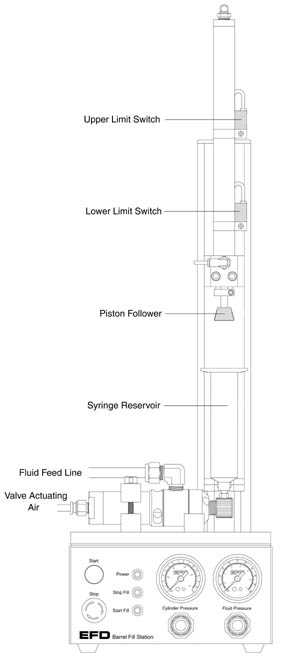Increased batch sizes, coupled with the need to control costs and maintain product quality, prompted the company to search for a faster, more accurate way to fill the 30cc and 55cc syringes that many customers require. A solution was found in a new syringe-filling system that has helped achieve a 100 percent increase in packaging speed while keeping fill weights within tight tolerances.

Rising Demand Prompts Search for Better Filling Method
“Mixing the batch was really the easy part,” said Process Engineer Zach Gragen. “Most of our time was taken up with packaging, especially as we began making larger and larger batches.”Gragen says that, until recently, members of the Special Packaging team transferred material from bulk containers to the syringes using a ram press or a ram pump fitted with a manually controlled on/off valve. The operator would first insert a piston, then thread the syringe onto a fitting extending from the press or pump. A simple sight gauge, consisting of a metal rod with a groove scribed on its circumference, was inserted into the syringe. To fill, the operator moved a lever to open the valve and let material flow into the syringe. It was crucial that the operator pay close attention to the fill line on the gauge — as soon as it reached the top of the syringe, the operator quickly closed the valve, capped the syringe and set it aside for labeling.
While this method produced acceptable results, it was a slow process; even an experienced operator could fill no more than three syringes a minute. In addition, there was no way to guarantee that each syringe was filled with a consistent volume of material. This posed a potential problem, according to Harry Falasca, Special Packaging team leader.
“Customers with automated production facilities typically calculate how many deposits they can get from a certain size syringe,” Falasca explains, “so if a syringe was ever underfilled, it could empty faster than anticipated.
“To keep this from happening, we slightly overfilled every syringe, especially the opaque black ones we use for light-sensitive materials. But since many facilities use sensors to monitor how much material is left in the syringe, we had to be very careful to keep the position of the piston within a very tight range so they could get accurate readings.”
A Faster, More Accurate Filling System
Many of the materials produced at the Canton facility are temperature-sensitive and must be produced, packaged and refrigerated within a specified time to ensure product integrity.As Falasca and his team started preparing adhesives in larger batches, they needed to find a way to fill the syringes quickly without compromising the accuracy of the fill weights. A new filling system developed by their main syringe supplier turned out to be the solution they needed.
Unlike typical syringe filling systems, which are often manually controlled or bulky and complex to operate, the 8000BF from EFD Inc., East Providence, RI, makes the process fast and foolproof. In just a few minutes, any worker can be trained to fill every syringe with the correct amount of material.
Setup of the compact system is simple and efficient. The operator plugs in a power cord, connects a hose to the plant’s compressed air supply, and runs a feed line from the adhesive reservoir. (The system can be supplied by anything from a 6-oz cartridge to a 55-gal drum.) Fluid pressure is adjusted to produce the desired flow rate/fill speed, and the upper and lower limit switches are used to set the fill volume.

Accurate Fills Eliminate Waste and Giveaway
With fill weight established and automatically controlled by the limit switches, there is no need to insert, monitor, and remove a fill gauge. The operator just places the syringe on a fitting and either presses a button on the unit’s front panel or taps an electronic foot pedal to initiate the fill cycle.As the syringe fills with material from the bottom up, steady pressure is applied to the top of the syringe piston to minimize the chance of voids or bubbles being introduced into the material. If the user should inadvertently activate the system without a syringe or piston installed, a safety sensor will prevent the unit from operating.
After experimenting with the EFD system, Falasca and his crew found they could increase their fill rate to six syringes a minute — twice the previous speed — with less than +/-2 percent deviation from the target weight. The increased accuracy eliminated the need to overfill the syringes, thereby reducing waste.
Pleased with the improvements obtained with their first system, Emerson & Cuming soon had two more EFD units on the packaging floor. All three were mounted on carts so they could be moved as needed to different areas of the facility. As the equipment became fully integrated into their daily production routine, the Special Packaging team was able to streamline the filling sequence even further.
Syringes are now ordered with the pistons pre-installed, which has further reduced fill time by eliminating an extra step from the process. To keep pace with the increased fill speeds they have achieved, Emerson & Cuming has purchased a benchtop labeling system that allows workers to pre-label an entire batch of syringes in advance. Now as each syringe is filled, the operator simply caps it and sends it on its way — formulated, filled, labeled and ready for refrigeration within the specified timeframe.



